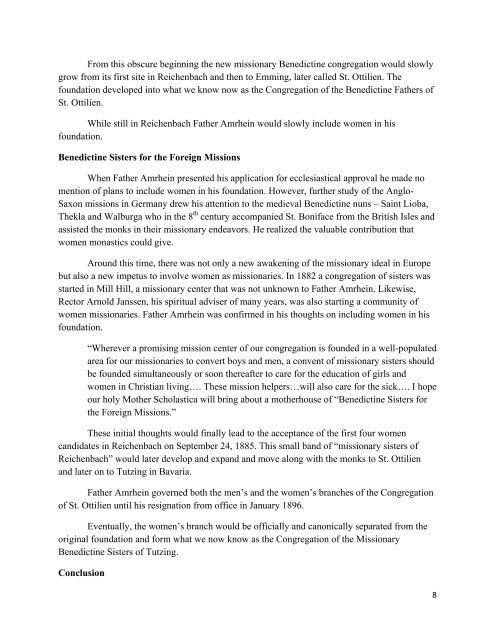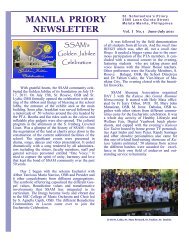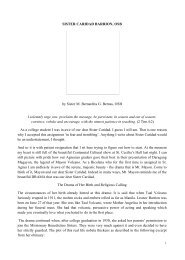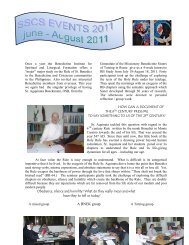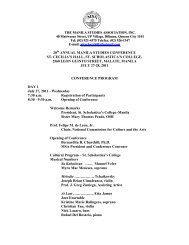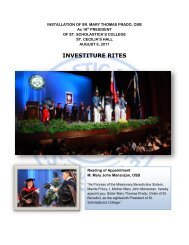Fr. Andreas Amrhein, OSB - St. Scholastica's College
Fr. Andreas Amrhein, OSB - St. Scholastica's College
Fr. Andreas Amrhein, OSB - St. Scholastica's College
You also want an ePaper? Increase the reach of your titles
YUMPU automatically turns print PDFs into web optimized ePapers that Google loves.
<strong>Fr</strong>om this obscure beginning the new missionary Benedictine congregation would slowly<br />
grow from its first site in Reichenbach and then to Emming, later called <strong>St</strong>. Ottilien. The<br />
foundation developed into what we know now as the Congregation of the Benedictine Fathers of<br />
<strong>St</strong>. Ottilien.<br />
While still in Reichenbach Father <strong>Amrhein</strong> would slowly include women in his<br />
foundation.<br />
Benedictine Sisters for the Foreign Missions<br />
When Father <strong>Amrhein</strong> presented his application for ecclesiastical approval he made no<br />
mention of plans to include women in his foundation. However, further study of the Anglo-<br />
Saxon missions in Germany drew his attention to the medieval Benedictine nuns – Saint Lioba,<br />
Thekla and Walburga who in the 8 th century accompanied <strong>St</strong>. Boniface from the British Isles and<br />
assisted the monks in their missionary endeavors. He realized the valuable contribution that<br />
women monastics could give.<br />
Around this time, there was not only a new awakening of the missionary ideal in Europe<br />
but also a new impetus to involve women as missionaries. In 1882 a congregation of sisters was<br />
started in Mill Hill, a missionary center that was not unknown to Father <strong>Amrhein</strong>. Likewise,<br />
Rector Arnold Janssen, his spiritual adviser of many years, was also starting a community of<br />
women missionaries. Father <strong>Amrhein</strong> was confirmed in his thoughts on including women in his<br />
foundation.<br />
“Wherever a promising mission center of our congregation is founded in a well-populated<br />
area for our missionaries to convert boys and men, a convent of missionary sisters should<br />
be founded simultaneously or soon thereafter to care for the education of girls and<br />
women in Christian living…. These mission helpers…will also care for the sick…. I hope<br />
our holy Mother Scholastica will bring about a motherhouse of “Benedictine Sisters for<br />
the Foreign Missions.”<br />
These initial thoughts would finally lead to the acceptance of the first four women<br />
candidates in Reichenbach on September 24, 1885. This small band of “missionary sisters of<br />
Reichenbach” would later develop and expand and move along with the monks to <strong>St</strong>. Ottilien<br />
and later on to Tutzing in Bavaria.<br />
Father <strong>Amrhein</strong> governed both the men’s and the women’s branches of the Congregation<br />
of <strong>St</strong>. Ottilien until his resignation from office in January 1896.<br />
Eventually, the women’s branch would be officially and canonically separated from the<br />
original foundation and form what we now know as the Congregation of the Missionary<br />
Benedictine Sisters of Tutzing.<br />
Conclusion<br />
8


